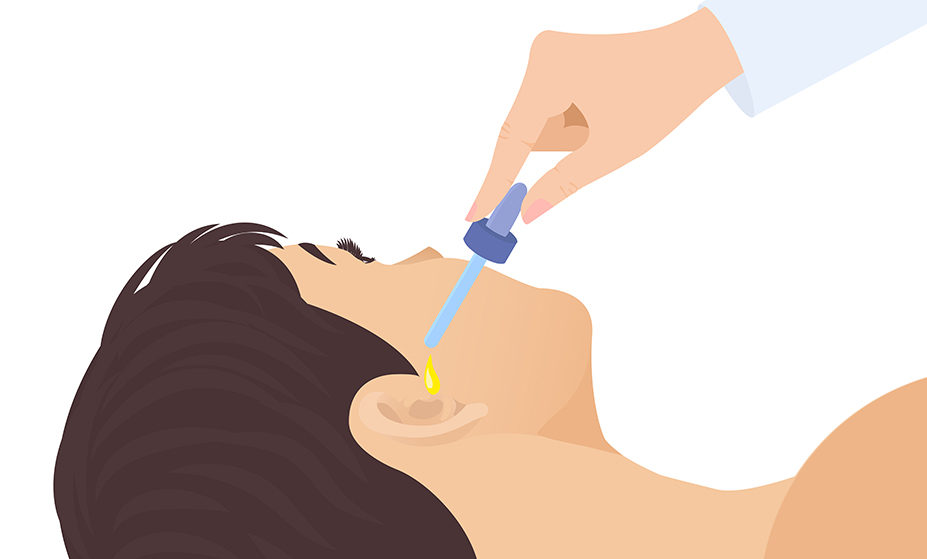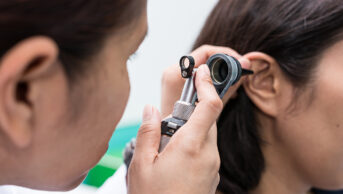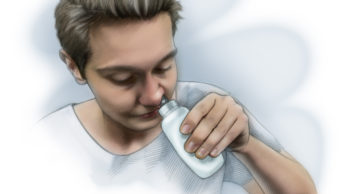
Shutterstock.com
Acute otitis media (AOM; middle ear infection) is very common in children — so common that one in four children will experience at least one infection by their tenth birthday[1].
The symptoms of AOM can be distressing for a child: they may experience earache; they may rub or pull on their ear; and they may experience non-specific symptoms, such as fever, crying and restlessness. The condition is also distressing for parents or carers, who may feel helpless when looking after them — sleepless nights and days off work and school are frequently reported as a direct result of AOM.
The condition is much more common in children than in adults, since children have a shorter and more horizontal eustachian tube — the tube connecting the throat and middle ear. Inflammation and obstruction in this tube can lead to building pressure and accumulating fluid, which is then colonised by bacteria and viruses.
The infection can be bacterial in nature but is much more commonly caused by viruses[1].
Parents and carers should be advised that AOM is a self-limiting condition, which should resolve within three to seven days; most of these conditions get better without antibiotics[2]. However, despite viral AOM being much more common, too many antibiotics are still being prescribed for the condition. A review study by Williams et al., published in 2015, showed children diagnosed with AOM were prescribed antibiotics 70% of the time[3].
Pressure to prescribe
Among parents, there is often a belief that antibiotics are the solution for relief from the symptoms of AOM and, because of this, GPs can often be put under pressure to prescribe antibiotics for children, even when they are not indicated.
The National Institute for Health and Care Excellence (NICE) suggests that antibiotics should be prescribed only to children aged under two years with bilateral AOM (affecting both ears), with otorrhoea (drainage from the ear)[4].
For those who are systemically unwell, or whose symptoms are persistent, a back-up antibiotic prescription should be considered, along with advice for parents and carers about antibiotics not being needed immediately. The antibiotic prescription should be dispensed only if symptoms don’t improve within three days, or get significantly worse, and parents and carers should be advised to give the child standard analgesics, such as paracetamol and ibuprofen.
‘Wait and see’ strategies have been shown to be safe where there is low risk of complications
For those who are systemically unwell, or whose symptoms are persistent, a back-up antibiotic prescription should be considered, along with advice for parents and carers about antibiotics not being needed immediately. The antibiotic prescription should be dispensed only if symptoms don’t improve within three days, or get significantly worse, and parents and carers should be advised to give the child standard analgesics, such as paracetamol and ibuprofen. ‘Wait and see’ strategies have been shown to be safe where there is low risk of complications[4].
Aim for the pain
The overuse of antibiotics is already contributing to antimicrobial resistance. Children receive a significant proportion of antibiotics each year and, as a result, represent an important group to aim our efforts at in reducing unnecessary prescribing across conditions affecting children. One UK study found that 80–84% of children presenting to primary care with AOM were prescribed an antibiotic[5].
Reducing the use of unnecessary antibiotics for all children would also reduce the risk of side effects associated with their use, such as diarrhoea, rashes, nausea and vomiting. Evidence has shown that for every 14 children treated with antibiotics, 1 had an adverse effect[6].
In treatment for AOM particularly, we need a strategy to reduce antibiotic prescribing and central to this is analgesia[6].
The distress of AOM is most often put down to pain, so tackling this pain should be our primary aim. Indeed, NICE’s 2018 otitis media antimicrobial prescribing guidelines suggested that anaesthetic eardrops may improve pain when used with oral analgesics[7].
But there was a problem: at the time, there were no ear drops licensed in the UK, and the cost of importing them or getting them made at a specials unit was not economically viable for many organisations.
In 2019, one small study conducted in the UK — the Children’s Ear Pain Study (CEDAR) — sought to find out whether treating children’s ear pain with anaesthetic-analgesic eardrops was an option in primary care[8].
The study randomised children to three groups: anaesthetic-analgesic (Auralgan; Paladin) drops, placebo drops and usual care. The study provided evidence that anaesthetic-analgesic eardrops use resulted in reduction of antibiotic consumption in children presenting with AOM in primary care, compared with usual care. Parents were also interviewed during the study, and they expressed their willingness to buy over-the-counter eardrops with guidance from a pharmacist. However, the small sample size (n=106) and problems with recruiting meant that any effect on pain could not be ascertained.
Pain-relieving eardrops
Nevertheless, in other countries, such as Australia, anaesthetic-analgesic ear drops are widely used in controlling ear pain and thus reducing the dependency on solely antibiotics. And, since the NICE guidelines were published, there is now a licensed option that can be recommended for use in AOM.
Otigo, licensed by Renascience Pharma in June 2019, is a prescription-only medicine that combines two methods of relieving pain: anaesthesia/analgesia and anti-inflammatory action. The local, topical effect it offers reduces the risk of systemic side effects. Otigo is the only UK licensed analgesic/anti-inflammatory ear drop combining an anaesthetic (lidocaine) with a non-steroidal anti-inflammatory (phenazone). It is indicated for local symptomatic treatment and relief of pain in the middle ear without tympanic perforation: acute otitis media, otitis in influenza and barotraumatic otitis. The use of analgesic ear drops can also overcome oral medication non-compliance and adherence concerns frequently observed in the paediatric setting.
Some local commissioning groups have included Otigo eardrops as recommended first line treatment for AOM[9]. These pain-relieving eardrops may be beneficial for children who resist oral medication, and basic analgesia, such as paracetamol and ibuprofen, can be used alongside them to manage general pain and fever.
Pharmacists are antibiotic stewards
We all know the importance of good antibiotics stewardship. However, in England, the community pharmacist consultation service and the use of independent prescribing pharmacists in other areas of the UK enable pharmacists to play a direct role in educating parents and carers about best treatment.
I believe that our profession should place itself at the forefront of the drive to reduce unnecessary antibiotic consumption in AOM, by encouraging the wider use of analgesic ear drops, such as Otigo, to deliver effective and localised analgesia. We should explain to parents, carers and other prescribers the other advantages of these treatments on patient palatability, non-compliance and reduced systemic side effects, and encourage a permanent shift in care for viral AOM. It is time to start aiming for pain.
Wasim Akhtar, consultant pharmacist and clinical research associate, Scope International Ltd
Amna Hassan, locum GP
Eusra Hassan, paediatrician, Manchester Royal Infirmary
The authors did not declare any conflicts of interest when submitting this article.
- 1Middle ear infection (otitis media). NHS Inform. https://www.nhsinform.scot/illnesses-and-conditions/ears-nose-and-throat/middle-ear-infection-otitis-media (accessed 11 Oct 2021).
- 2Atkinson H, Wallis S, Coatesworth AP. Acute otitis media. Postgraduate Medicine 2015;127:386–90. doi:10.1080/00325481.2015.1028872
- 3Williams MR, Greene G, Naik G, et al. Antibiotic prescribing quality for children in primary care: an observational study. Br J Gen Pract 2018;68:e90–6. doi:10.3399/bjgp18x694409
- 4Clinical Knowledge Summary: Acute Otitis Media. NICE guideline NG1. National Institute for Health and Care Excellence. 2013. https://cks.nice.org.uk/topics/otitis-media-acute/ (accessed 11 Oct 2021).
- 5Williamson I, Benge S, Mullee M, et al. Consultations for middle ear disease, antibiotic prescribing and risk factors for reattendance: a case-linked cohort study. Br J Gen Pract 2006;56:170–5. https://www.ncbi.nlm.nih.gov/pubmed/16536956
- 6Venekamp R, Sanders S, Glasziou P, et al. Antibiotics for acute otitis media in children. Cochrane Database Syst Rev 2015;:CD000219. doi:10.1002/14651858.CD000219.pub4
- 7Otitis media (acute): Antimicrobial Prescribing. National Institute for Health and Care Excellence. 2018. https://www.nice.org.uk/guidance/ng91 (accessed 11 Oct 2021).
- 8Hay AD, Downing H, Francis NA, et al. Anaesthetic–analgesic ear drops to reduce antibiotic consumption in children with acute otitis media: the CEDAR RCT. Health Technol Assess 2019;23:1–48. doi:10.3310/hta23340
- 9Management & treatment of common infections – guidance for primary care. NHS Somerset Clinical Commissioning Group. 2021. https://www.somersetccg.nhs.uk/wp-content/uploads/2021/04/managing-common-infections-guidance-for-primary-care-may-21-v1.1.pdf (accessed 11 Oct 2021).


